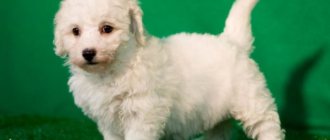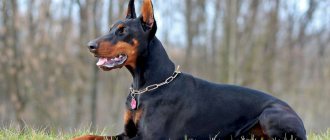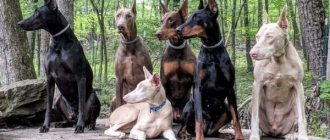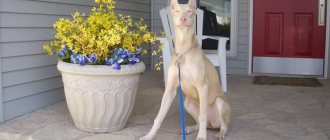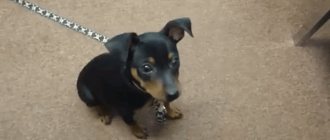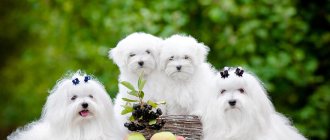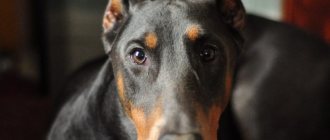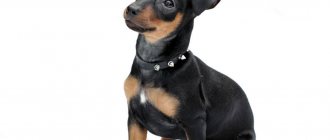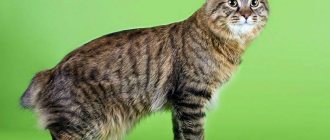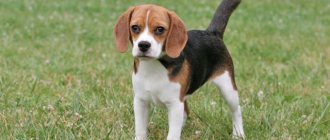History of the breed
Doberman dogs began their existence at the end of the 19th century. In the 1870s, the German stray dog catcher Friedrich Dobermann set out to develop a breed that would combine endurance, courage, fearlessness, good reflexes and amenability to training. The result of experimental crossings of old German pinschers and the ancestors of modern Rottweilers, the so-called “butcher” dogs, was the Doberman. The original name of the breed - Thuringian Pinscher - was given by the name of the German province, where in the Thuringian city of Apolda its creator Friedrich Dobermann was engaged in breeding this breed.
In 1887, at a dog show in Erfurt, the dog was officially presented. 1890 is considered the year of recognition of the breed. And in 1894, after the death of Dobermann, the name “Thuringian Pinscher” was replaced by “Dobermann Pinscher”.
In 1899, the official standard for the Doberman Pinscher breed was approved.
Only a few decades later, in 1949, the wording “Doberman Pinscher” was shortened to the name familiar to today’s dog breeders.
Photo of Doberman Pinscher dog
The official entry of the breed into the register took place only in February 1994. This was done by the International Canine Federation. In her registry, she noted the Doberman breed under registration number 143 and identified Germany as the homeland of these dogs.
Advantages and disadvantages
Dobermans are extremely loyal. There are cases when one of a pair of these dogs died, the second, sad, also died. Shows loyalty and love to the owner and children. An excellent security guard. However, he needs attention, long walks and a strong-willed owner. Who will be able to educate him.
Dobermans are powerful, active, reliable dogs. Good friends and brave defenders.
To obtain this breed, the following were involved:
- Great Dane;
- German Pinscher;
- Rottweiler;
- German Shepherd;
- English shorthaired greyhound;
- Manchester Terrier.
They were originally bred as guard dogs, but eventually began to be used as police, military, therapy and rescue dogs.
Description of the Doberman breed
The Dobermann (German: Dobermann) is a breed of dog distinguished by its grace, clear lines and slenderness. The Doberman is amazing with its appearance! The contours of the muscles are clearly visible in all parts of the body. The anatomical nuances of the Doberman's physique allow the dog to develop great speed and instantly change the direction of movement.
Hurry up, choose a box and find out what gift awaits you
Discount on pet insurance
Promo code copied to clipboard
The silhouette, in accordance with the characteristics of the breed, is slightly inclined towards the lower part, with a smooth transition of lines from one part of the body to another. According to the breed standard, the length of the Doberman from the scapulohumeral joint to the ischial tuberosity does not exceed 5% of the height at the withers in males. In females this proportion does not exceed 10%.
Head
The shape of the skull when viewed from above has a wedge-shaped configuration with medium length. The difference between the Doberman's head is the parallel orientation of the facial and frontal planes of the skull. The cheeks fit tightly to the lateral axes of the head, and muscular outlines are clearly visible on them.
The anatomy of the head and its components makes the Doberman suitable for official purposes, search operations, and security. As a defender, such a dog copes well with the aggression of attackers - the force of its bite reaches 8 atmospheres. And the jaws compress with a power of up to 143 kg.
Muzzle
The proportionality of the muzzle and skull is related as 1:1. Gradually narrowing from the base of the skull to the nose, the head in the muzzle area becomes narrow and slightly elongated. There is no sagging or convex shape on the cheeks. The lips are tightly pressed to the base of the dentofacial apparatus, do not sag, and are tightly compressed.
The upper and lower jaws are very well developed, widening towards the skull and tapering towards the nose.
When opened, the mouth opens wide, exposing the outer teeth - molars. The greatest width of the muzzle is in the area where the upper and lower incisor teeth are located.
The teeth of these dogs are white, the gums of the black Doberman are an exceptionally dark color, while in puppies and adult dogs the gums are brown - the shade of the gums is lighter. This breed of dog is characterized by the presence of 42 teeth with the correct location in the mouth and average size. The Doberman has a scissor bite.
The nose has a wide and massive lobe, well-developed wide nostrils that do not protrude too much beyond the contours of the muzzle.
Eyes
The eyes are oval in shape, with dark pigmentation of the pupils. Brown representatives of this breed usually have a slightly lighter eye shade, which does not contradict the standard and description of the breed. Standard representatives of the Doberman breed at any age - from a puppy to an adult pet - should not have protruding eyes. They are either in line with the lateral axis of the cranium, or just below it.
Ears
In their natural form, in puppies or in an adult dog without cropping, the ears should be drooping and fit snugly to the lateral planes of the skull and cheeks. Dobermans' cropped ears are always erect. They clearly taper towards the top.
The ears of a Doberman are located on the head in the highest area of the head and are of medium size. Thanks to the natural characteristics and anatomical structure of the ears, the Doberman has excellent hearing.
Neck
Young and adult dogs are characterized by grace in all anatomical parts of the body. The lines of the neck also have such grace - even at an early age, a straight and long axis of the neck with massive vertebrae and well-developed muscle tissue is formed. The muscularity of the Doberman's neck is clearly visible under the skin in any color, especially when moving.
Along the upper axis, the neck has a smooth, graceful curve. Both at rest and during movement, the neck is always kept in a straight position. In males, the withers in the neck area are more prominent, in females there is almost perfect uniformity, which narrows slightly from the bottom to the base of the skull.
Photo of Doberman Pinscher dog
The Doberman's neck is positioned vertically; the neck always seems to support the head above the upper axis of the body. The proportionality of the length of the neck of this breed and the length of the skull are equal.
Frame
The Doberman's exterior, distinguished by its slender lines and texture of muscle mass, has its own characteristic nuances. The croup is slightly sloping downwards and has a wide upper part. From the tops to the base of the tail the slope is only slightly noticeable. According to the breed standard, a sharp transition from horizontal lines to a sloping croup is not allowed. Closer to the tail it acquires rounded shapes.
A slight increase in width is noticeable in the lumbar region. In bitches, the lumbar region is slightly elongated, which is dictated by the anatomical differences in the reproductive organs. Characteristic features of the back are compactness and prominent muscle tubercles. The back is short when measured from the crown to the beginning of the withers.
The Doberman's withers are distinguished by their elongation, vertical position and length. It determines the angle of inclination of the upper part of the body, starting from the withers towards the croup. In the area of the withers, the muscularity of the upper part of the exterior is also clearly visible.
The chest touches the area of the elbow joint. It has a moderately wide shape. In individuals of any age, including young pets, the chest is always oval, almost barrel-shaped. On the lateral planes the chest is slightly flat. A narrow or rounded chest is considered a fault and does not meet the breed standard.
The elegance of the exterior of such graceful dogs is largely achieved thanks to a toned belly with elegant lower lines and a characteristic smooth curve.
Front legs
Strictly vertical, without tilting, the forelimbs are well developed. The front legs are straight along the entire axis. In the area of the shoulder joint they form an angle of up to 100-110 degrees. All bones of the humeral region are of average length. Upon examination, the developed muscles of the shoulder joint are clearly visible.
Other parts of the Doberman's forelimbs have the following signs and characteristics corresponding to the breed standard:
- The elbow joints have a posterior direction, without everting the heads of the ulna bones.
- The strong forearm has a straight shape, with pronounced muscles and a harmonious average bone length.
- The shoulders of Doberman dogs are oblique, tightly fitting to the chest. They protrude slightly over the thoracic vertebrae. The shoulders have an angle of 50-55 degrees relative to the horizontal axis of the body.
- The musculature of the shoulders is clearly visible on both sides of the shoulder crest.
- At the bottom of the forelimbs there are wide wrists with a clear relief and quite strong.
- The pasterns of Dobermans are well developed, have a strong and dense structure. When viewed from the front they have a straight shape. The slight slope of the Doberman's pastern is slightly visible when viewed from the side. The angle of inclination in accordance with the standards of the Doberman dog breed does not exceed 10 degrees.
The paws of the forelimbs are small, shortened, and have a lumpy shape. They slightly resemble the appearance of cat paws. The toes are arched, with dark claws of short length.
Hind legs
Thanks to the anatomical properties of the hind limbs, the movements of the Doberman are always springy, fast and elegant. The dog's free and sweeping stride allows him to quickly develop speed and cover long distances. When running, the hind legs extend perfectly and provide a pushing effect. The developed muscle tissue of the hind limbs imparts shock-absorbing properties during movement - the Doberman easily pushes off with them from a solid base with noticeable elasticity.
When moving, the hind paw moves synchronously with the front paw of the opposite side.
In the pelvic area, the muscles of the hind legs form a convex shape, which is why the croup and hip joint appear rounded. The muscles are well developed across the width of the shins and thighs.
The direction of the hind limbs is vertical, with a straight axis. Both hind legs of the Doberman are strictly parallel to each other. In individual anatomical fragments of the hind limbs, characteristics characteristic of the Doberman can be traced:
- The hips consist of medium-length bones, on top of which there is a dense layer of muscle fibers. Together with the horizontal axis of the upper back, the Doberman's hip joint forms a slope with an angle of up to 82-85 degrees.
- The knee joint angle is approximately 125 degrees. The articulation of the lower leg, part of the thigh and the kneecap is very strong and durable.
- The anatomy of the lower leg of the hind limbs is represented by medium-length bones with a strong structure, which is proportional to the length of the entire hind leg.
- The Doberman's hock joint is distinguished by its high strength and strong build. His angle of conjugation of the metatarsus and tibia is 135-140 degrees. The metatarsus itself has a vertical axis, is set straight and consists of short bones.
The lower part of the Doberman's hind limb is short and arched. The paws have the shape of a lump. The size of the claws, like those of the forelimbs, is short. All claws are absolutely dark, uniform in color.
This anatomy of the hind legs dictates both the physiological and physical capabilities of the Doberman. Thanks to this, the dog can reach speeds of up to 36-38 km/h.
Tail
According to the breed standard, the Doberman's tail must be docked. In this case, only the two upper vertebrae are left. If docking is not carried out (the reason for this may be a ban on the operation in some countries or refusal of the owners), then the tail remains in its natural shape. It has an almost straight, curl-free shape. Toward the end it is slightly curved upward. The fur on the tail is short.
Wool
The Doberman's coat is densely packed onto the skin with one-dimensional pigmentation. The skin itself is of a contracting type, tightly adjacent to the muscle fibers.
Dobermans are characterized by short and coarse hair. She has increased density. The fur is smooth to the touch and lies evenly over the entire surface of the body. The presence of an undercoat is unacceptable for this breed, so the coat is packed tightly to maintain body temperature stability and protect against frost. Healthy animals have shiny coat, regardless of color. Changes in density, loss of shine and the appearance of curly curls indicate metabolic disorders or the appearance of invasive diseases.
Size
The Doberman is a medium-sized animal with moderate body weight. Males of this breed reach a weight of up to 42-45 kilograms. Bitches are usually lighter due to their anatomical and physiological characteristics - their weight is usually between 30-35 kg.
When measured at the highest point of the body, the height of the Doberman at the withers should have the following indicators:
- Males have a height of approximately 68-73 cm with proper maintenance and feeding;
- bitches are always a little more compact: their height at the withers is about 62-68 cm.
Excessive massiveness of males or dry and thin exterior of females are a deviation from the standards for describing the Doberman and the characteristics of the breed.
Defects include such disproportions in the exterior as a shortened neck, a narrow or too wide head, sagging skin, as well as an excessively downward sloping body, a long tail, uneven placement of the limbs or an excessive angle relative to the vertical axis.
During exhibitions, the size of the Doberman is assessed, while the standards provide for a maximum deviation from the norm of no more than 2 centimeters.
Photo of Doberman Pinscher dog
What to do if your weight is below normal?
If the puppy’s weight is below normal, first of all, you should understand the reasons.
Possible reasons:
- Weaning from mother . This is a serious test and stress for every puppy. In the first month after weaning and transfer to new owners, the baby may not only stop gaining weight, but even lose it. In order to avoid this, babies are given calcined cottage cheese with yolk and liquid vitamins (dosage should be checked with a veterinarian). If the mixture is thick, dilute it with milk.
- Worms are also a very common cause of weight loss . As a rule, the first time anthelmintic is given to a baby at 2 months of age, but if there is a suspicion of the presence of parasites, then the anthelmintic can be given earlier. Before you start, you need to visit a veterinarian and identify the type of worms. After this, the doctor will prescribe one drug or another, taking into account the age and weight of the baby.
- Nutrition - if the baby is stunted, but does not suffer from any disease, pay attention to his nutrition. Include vitamins, nutritional supplements or vitamin-mineral complexes in your puppy's diet.
IMPORTANT!
A normally developing puppy in the third month of life should increase in height by approximately 2 times.
Color
Initially, the breed standard, approved in 1899, recognized exclusively black color. In 1901, the Association of Dog Trainers included representatives of these brown dogs in its register.
In accordance with the established characteristics of the breed, there can be two types of Dobermans based on coat color:
- black;
- brown.
With the exception of Britain and the USA, only these two coat colors are recognized in all countries.
The color of both varieties of this breed has a remarkable feature - the presence of tan or red tan.
In both the black Doberman and its brown relative, you can see such tan marks in the eyelid area, on the cheekbones, and in the chest area between the forelimbs. Similarly, such markings are visible inside the ears, near the mouth and under the tail. There are also such tan marks on the limbs of the hind and front legs.
Black Dobermans
In frequently seen photos of a Doberman, you can usually see a dog of this breed with exactly this color. Such animals with their dark coat color make an indelible impression, emphasized by the contrast of color of almost the entire body and local lightened tan marks in certain areas.
This color is considered the main color for these dogs.
However, some puppies are born entirely of this color, with barely noticeable darkened tan marks. Such dogs are not allowed to participate in exhibitions. Likewise, they are not used for purebred breeding and production of puppies. But in service dog breeding, such pets bring benefits no less than their relatives with the appropriate coat color.
Melanism - a uniform color - is considered a defect; such cases are rare.
The advantage of dogs of this breed with this color is their bright red tan, which contrastsly emphasizes individual elements of the exterior. Darkening or too light a shade is considered an anomaly.
The classification of colors with this coat color suggests two options:
- anthracite - with shiny wool;
- deep dark - with a slight reddish tint, noticeable in the sun's rays.
Such features are dictated by the action of dominant genes. In the first case, this is the result of purebred genetics. In the second, it is a consequence of greater activity of genes that contain a red tint.
Brown Dobermans
Dog breeders consider the advantage of the brown color to be its visual appeal. Shades from red to dark chocolate give the dog softness, while significantly enlarging the body when visually assessed. Dogs' eyes are brown, with a slightly light tint. The color of the nose is light brown, uniform.
Brown Doberman
In addition to these colors, there are varieties of dogs with non-standard coat colors. These include albinos (usually white), who are not recognized by dog handlers in any country in the world. In addition, as a result of genetic disorders, even parents of the same color may produce offspring of isabella, blue, or red shades. All of these colors of Dobermans are considered abnormal, and such dogs are not allowed to breed with purebreds of a standard color or to participate in exhibitions.
How to measure height correctly?
As you know, a dog's height is measured from the withers. There is even a corresponding expression (height at the withers). But what is withers and how to find them?
The withers are the area of the spine that is located between the dog's shoulder blades . As a rule, in dogs this is the highest point of the body. It is by this that growth is measured.
By all standards, a dog’s height is the distance from the support (paw) to the withers.
How to measure height:
- To measure height, the dog is placed in a special stance (it is advisable to train the pet to take it on command). The dog is in a standing position on a flat surface. In order for the dog to behave calmly, they usually hold a treat or a favorite toy near its muzzle. And so that the dog does not worry, you can let him smell the measuring instruments.
- As a rule, a pet's height is determined using a special ruler or square. You can also use a special measuring stick. It is placed on the withers of the animal, so that it touches the body, but does not put pressure on it.
- When taking measurements, the ruler or corner must be in a strictly vertical position. If the measurement is made using a corner, its tape should in no case touch the plumb line.
- Measurements of the same dog are carried out 3-4 times, within several minutes, only then the calculations are considered correct. If the indicators differ, then the average value is taken and this is considered the result.
Character of Dobermans
Fearless, energetic and attentive are three qualities that are characteristic of the Doberman. At the same time, there is a widespread belief that this is an aggressive breed: the dog can attack a stranger. This is fundamentally wrong. With proper upbringing, the animal will have a neutral attitude towards strangers, and will show aggression only if it decides that the owner is in danger. But pay attention: a trained animal will never show initiative; it will obey its owner.
A Doberman and a human get along well, but only if that person is the owner. The dog always obeys its owner and, despite its protective and fighting qualities, is considered quite friendly. A characteristic quality of this breed is vigilance. Dobermans are always on the alert, always ready to rush to defend their territory or owner, they notice any dangers in time. Regardless of whether the threat comes from other dogs, wild animals or aggressive people, the Doberman reacts instantly, and his friendliness abruptly gives way to bold, energetic attempts to limit aggression and danger.
The character of the representatives of this rather intelligent breed allows them to get along with other animals if they have known each other since childhood. Otherwise, the reaction to a new pet may be unpredictable. And in this case, everything also depends on the training and upbringing of the dog. This is especially evident in the relationship between male dogs. These are dominant individuals who always try to emphasize their superiority over their relatives. But this behavior is corrected during the training process.
Another striking sign in the behavior of these dogs is their affection. Even during walks, they try not to move away from their owner. Dobermans are not distracted even by their relatives of the opposite sex if the owner is nearby during a walk and does not let them go too far from him. At the same time, such devotion has its limits. In the family, only one member has unquestioning and unlimited influence on such a pupil. Such a dog obeys the rest of the family members less willingly and mainly in the presence of the one who walks, feeds and trains it.
At the same time, a pet kept in a family will not show its fighting qualities towards young children without reason or ignore them. Moreover, he perceives them as equals and is even ready to plunge into active games with the kids.
The protective qualities of the breed sometimes manifest themselves in the most unexpected ways. The character of the Doberman is distinguished by its keen interest in the people and animals around it, as well as its excellent lightning-fast reaction. Therefore, any sudden movements of strangers or unexpected circumstances instantly provoke a defensive reflex.
Meanwhile, the protective reflex and expressed readiness to stand up for oneself or the owner never appear without solid motives. These qualities must be provoked by the actions of people or animals, external circumstances. It is worth noting that females are more decisive in their actions, feeling like defenders of their own family. This is especially evident within the confines of a house or garden. Males are more balanced in their actions and much more cautious than females. They try not to show aggression until they are convinced that there is danger.
Owner reviews
Dobermanns talk about their favorite pets like this:
“My favorite pie! This is my-my dog."
“If you still decide to adopt a Doberman, then, with proper training, you will get a very smart, kind dog, attached to its owner.”
“She, of course, is an infection... But she is so beloved!!!”
“Before getting a Dober, you need to weigh the pros and cons. Dobermanns probably require more time for training and attention than anyone else, but this is only due to the fact that they are very people-oriented and are ready to do anything to get attention.”
“Once you get to know this breed, you don’t need another!”
Recommendations for education and training
The Doberman is a dog that, like no other, needs a strong leader. That is why a puppy of this breed cannot be raised by children, teenagers or people with weak character. If the future owner of a Doberman has no experience in dog training or it was unsuccessful, it is better to immediately contact a dog trainer.
At the same time, Dobermans are highly intelligent. This allows you to achieve quick and lasting training results. This breed is known for its intelligence and easy acceptance of new commands. During training, the owner must constantly emphasize his superiority and avoid any concessions. The main three criteria for successful Doberman training are:
- consistency - you should not start performing new actions and commands until previous skills have been consolidated. Moreover, consistency must also be manifested on the part of the Doberman himself: he must carry out commands correctly, as required by the order;
- discipline is the most important condition, both for the Doberman and for its owner. You should strictly adhere to the allotted time for training. Bringing the achieved results to their logical conclusion and not softening your attitude towards the dog if something doesn’t work out are mandatory conditions;
- patience - the owner of a Doberman, with all the dog’s trainability and excellent intelligence, must show persistence in any weather and in any mood.
To achieve maximum obedience and unquestioning execution of commands, it is better to train your pet from an early age. Doberman puppies, despite their intelligence, already from the age of four months are perfectly aware of what their owner requires of them.
Price, where and how to buy, cost of a puppy
Step-by-step instructions for those wishing to purchase a puppy:
- Actively studying information about the breed in Doberbase and social network groups. For example, here and here
- Determining the purposes for which the dog is needed, including visiting exhibitions or sports training. In the first case, it is better to choose a show-level dog; in the second, you should pay attention to litters whose mother, for example, is a show dog, and whose father actively works on the training ground and shows excellent results. It's not easy, but who said that choosing a puppy is a nonsense and quick thing?
- Choosing a trusted kennel that has proven itself among breed lovers. By the way, information about nurseries is in the indicated groups.
- Track litters in the selected nurseries or nurseries.
- Determining the litter from which you want to adopt a puppy.
- Call the breeder or owner of the bitch. Tell us about yourself, your goals for purchasing a puppy, be sure to ask about the parents, ask for a video of their work.
- Ideally, visiting the training area and watching the actual work of one of the parents.
- Choosing a dog handler. Hint: there is a Dobermann dog handler in Moscow, you just have to look for it. Call a specialist, agree on future classes.
- Visit to the breeder three weeks after the puppies are born.
- Getting to know your pet. The puppy may refuse to be a completely different baby than the one chosen from the photo. It happens that at first you liked one puppy, and when you met, your eye fell on his littermate. But this is fraught, because puppies from promising parents are usually booked in advance.
- Joyful anticipation and anxiety over the next few days.
- Hurray, finally! The puppy moved to a new home. Happy new life, dear owners!
And now about the cost. Today, the price of Doberman puppies varies between 70,000 rubles and 150,000 rubles. The cost depends on the reputation of the kennel, the titles of the parents and, for working dogs, the corresponding qualities.
Care and maintenance of Dobermans
The Doberman does not require particularly careful grooming. All the owner needs to do is brush and wipe the dog with a damp towel weekly. We must not forget about examining and cleaning your pet’s ears, eyes and teeth. Arrange for preventive cleaning and inspection once a week. To care for hair, it is better to use hair combs with dense, triangular-shaped rubber teeth.
Dobermans are best suited for high-quality dry and wet food for large dogs, which are available in manufacturers' lines, but you can consider other types of food. It is important to remember that they should not be mixed with homemade food (for example, cereals and meat).
It is better to coordinate the diet of a Doberman puppy with experienced dog handlers and veterinary specialists.
From time to time, as necessary, the claws should be trimmed - the Doberman's nails are not worn down too intensively.
If the dog is kept in a country house, then you can build an enclosure for it. But remember about the playfulness and activity of the pet: the area for keeping the Doberman must be sufficient - at least 7-8 square meters. However, constant keeping in an enclosure is undesirable: the dog must periodically enter the house. This will prevent the development of aggression and will contribute to the development of responsibility in the pet for the safety of the entrusted territory and owners.
Doberman puppies should not be overcooled - the place where they are kept must be warm. There should be a rug on the floor.
Diseases and health problems
There is a bitter opinion among modern Dobermans: if a dog has lived to be 8 years old, it is considered a long-liver. And if a pet manages to reach 10 years of age, they look at it as if it were a curiosity from another planet.
The lifespan of modern Dobermans is, on average, 5-7 years. The main diseases that claim the lives of pets:
- DCM. Almost 60% of the breed is susceptible to this heart disease. We won’t go into veterinary terms, but let’s just say: there are two types of disease development. In the first case, after diagnosis, the dog spends the rest of its life on the couch, taking a certain medicine. In the second case, the animal dies instantly: during training and play, just at home. When planning to purchase a Doberman, the future owner will have to accept DCM as a given and come to terms with its possible appearance in his own pet. Otherwise, it is worth considering a different breed.
- Oncology. Almost all pedigrees of modern dogs contain either DCM or cancer. Comments are unnecessary here.
- Von Willebrand disease is a bleeding disorder characterized by sudden bleeding. The disease is hereditary.
- Wobbler's syndrome is a disease of the cervical spine. The disease can be either congenital or acquired.
- Narcolepsy is a neurological disease characterized by sudden “falling asleep.” At the time of the attack, the animal becomes numb, and there is a short-term loss of control over the limbs. Narcolepsy is a genetic disorder.
- Gastric volvulus is a disease common to most large breeds. Volvulus is believed to be a hereditary disease.
- Hip dysplasia is not as common in Doberman Pinschers.
- Tendency to allergies.
Before purchasing a puppy, it is advisable to look into Doberbaza. Here you can find information about the ancestors of the desired puppy, more or less track the diseases of the parents, grandparents, etc.
Conditions of detention
Dobermans love physical activity, so they need many hours of walks and runs. In winter, it is worth purchasing warm clothes for them, because their wool does not contain undercoat, which warms the animals.
Dobermans are distinguished by fairly good health. However, you need to carefully monitor your dog's diet. Despite the fact that representatives of the breed have a stable digestive system, gastric volvulus often occurs, which is typical for large dogs with a wide chest.
Appearance and characteristics of the breed
Representatives of the breed look like proud Akhal-Teke horses. Some lovers compare Dobermans to graceful deer, the animals are so graceful.
According to FCI standard No. 143, a typical representative of the breed looks like this:
- The physique is strong and muscular.
- Elegant body lines.
- Proud and slender posture.
Such a dog was considered anatomically normal. Today the breed standard has changed somewhat. Light and lean brothers are gradually being replaced by dogs that are more reminiscent of Molossians. The difference in appearance is especially noticeable in docked and undocked animals.
As for the characteristics of Dobermans, perhaps they are one of the most owner-oriented dogs. The pet will look into the eyes and ask without words: are we going to play? What should I do for us to play?
With the right motivation, representatives of the breed work simply brilliantly: on the drive, with sparkling eyes and smiles from ear to ear.
Predisposition of Doberman Pinschers to Diseases
Starting from an early age, Doberman puppies are characterized by good health and endurance. Meanwhile, this breed is characterized by some hereditary pathologies:
- Wobbler syndrome, accompanied by disorders in the joints and vertebrae - dislocations, displacements;
- hypothyroidism is an abnormality of the thyroid gland;
- panostitis - congenital lameness without traumatic causes;
- dysplasia - pathological changes in tissue in the hip and elbow joint;
- von Willebrand-Jurgens syndrome is a bleeding disorder of blood components.
Some of these diseases are a result of the Doberman's weight putting pressure on his joints.
To maintain health, puppies and adults are recommended to be vaccinated against distemper, rabies, parvovirus, and hepatitis.
Attitude towards children and pets
She is quite tolerant of all family members if you raise her properly. In addition, all family members should interact with the dog, walk and train.
They can get along with other animals, but only if the owner takes the situation into his own hands. In skillful hands, the dog will be able to get along with all family members.
Tips for choosing a Doberman puppy
When choosing a Doberman puppy, you should first identify a reliable breeder. He must have documents for both parents - a male and a female. Only if you have a veterinary passport, pedigree documents, a certificate of origin and a mating certificate can you begin to choose.
Before reaching the age of six months, the breeder must issue a certificate for puppies from the entire litter, which is then changed to a pedigree at the Dog Breeding Federation or a canine center.
Photo of Doberman Pinscher dog
You should only choose an animal with obvious signs of the breed - one of two standard colors, with an appropriate exterior that matches the characteristics of the breed.
Puppies from a litter with a small number of individuals are always distinguished by greater health. Babies born first are always larger and more active. At the same time, you should pay attention to the following signs of health and conformity to the breed in young Dobermans:
- soft belly;
- smooth wool;
- wide jaws;
- square body shape;
- strong, pronounced bone structure;
- massive strong back.
To choose a Doberman pet with 100% confidence, it is better to invite an experienced dog handler.
Feeding and diet.
Oh, feeding Dobermans is a different story. The problem is that these dogs are very allergic, and recommending anything on their menu is such a pleasure.
Choosing a diet for a specific dog can only be done by trial and error. For some, the cheapest dry food is suitable, while others can only eat holistic food. And still others eat natural food and don’t know grief. In general, everything is very individual.
Puppies up to 3 months are fed 5 times a day, from 3 to 6 months - 4 times. Starting from the age of six months, the pet can be transferred to three meals a day. And a 9-month-old Doberman is quite capable of eating twice a day.
If your dog is on a natural diet, it is advisable to exclude chicken and beef from its menu. These products are allergens and, accordingly, can provoke an allergic reaction in a Doberman.
Health
Doberman Pinschers suffer from various diseases, some of them quite serious. These are both diseases characteristic of purebred breeds and large dogs. Different studies of life expectancy come up with different figures.
The average life expectancy is 10-11 years, but many dogs die much earlier due to health problems.
The most serious disease they suffer from is dilated cardiomyopathy (DCM). This is a myocardial disease characterized by the development of dilatation (stretching) of the cavities of the heart. The heart enlarges and weakens and cannot pump blood effectively. Since blood circulation weakens, all organs and limbs suffer. Although definitive studies have not been conducted, it is believed that about half of all dogs suffer from DCM at some point in their lives.
It leads to the death of the dog as a result of heart failure. At the same time, they have two forms of the disease: found in all breeds and characteristic of Dobermanns and Boxers. It cannot be completely cured, but the course of the disease can be slowed down, although medications are expensive. There are no genetic tests to determine susceptibility to DCM.
Doberman Pinschers are also prone to Wobbler's syndrome or cervical vertebral instability. With it, the spinal cord in the cervical region suffers, gait changes, and complete paralysis can occur.
But with von Willebrand disease, blood clotting is impaired, which makes any wounds extremely dangerous, since bleeding is difficult to stop. With severe injuries or surgery, the dog may die from blood loss. The danger is that dog owners find out about it too late and lose their pet.
Before agreeing to surgery, make sure your veterinarian is aware of Dobermans' predisposition to this disease. There are genetic tests that can diagnose it and allow responsible breeders to remove puppies with the condition.
Dobermans do not tolerate cold well, despite their double coat. It is short and simply cannot protect the dog from the harsh Russian frosts. In addition, they are muscular and slender; the fat layer that protects other dogs from the cold is minimal.
Not only can they freeze to death, but they can also get frostbite on their extremities. The sensitivity to cold is so high that in some countries, because of this, they even abandoned their use in the police and army. Owners should not walk their dogs for a long time in cold weather, and use shoes and overalls at this time.
In addition to ordinary ones, there are albinos. Their owners say that they are no different from ordinary ones, but breeders disagree with this. Albinos come from a mother who was bred with one of her puppies; all dogs of this color are the result of serious inbreeding.
It is believed (although there is no research on this topic) that they suffer from classic canine diseases, plus vision and hearing problems, especially deafness.
Nutrition
An appropriate diet will ensure your pet is healthy and in good shape. To determine how many times to feed your dog, you need to know its age. For puppies, feeding frequency is 4-6 times a day, for adults – 2 times.
When choosing what to feed your puppy, focus on the following products:
- boiled poultry and beef;
- boiled and fresh vegetables (except legumes);
- sea fish;
- dairy products.
For a baby, it is necessary that all the meat is ground and there are no bones in it.
When deciding what to feed an adult dog, use:
- boiled cereals (rice, buckwheat, oatmeal);
- bread;
- boiled vegetables;
- cottage cheese, yogurt;
- lean pork;
- raw eggs;
- sea fish;
- fresh herbs.
Your pet should always have a bowl of clean water. Change it at least twice a day.
Feeding balanced feeds requires special attention. To find out what kind of food you should feed your “aristocrat”, be guided by his weight. If he weighs less than 23 kg, treat the dog with canned food, if more than 23 kg - dry non-calorie food.
Make sure that the feed contains the necessary vitamins and minerals. Dogs should not overeat to avoid stomach bloating.
Protective and guard qualities
This pet is a born guard. Boundless loyalty, intelligence, lightning-fast reactions and fearlessness allow him to instantly assess the situation and take action. This dog is constantly ready to protect and defend its “pack” and its territory. These qualities are especially developed in female dogs.
It is interesting that representatives of this wonderful breed very clearly and accurately evaluate gestures, movements, intonations - almost the thoughts of a person.
They are able to identify a threat and raise the alarm. The concept that anyone outside the family can be an enemy is very clear to them. Therefore, Dobermans monitor everyone who appears in their home, their owners’ social circle, and are ready to react to any manifestation of a threat
